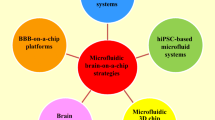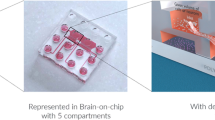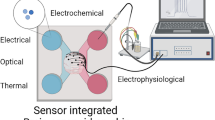Abstract
Unravelling the microenvironment of the human brain to investigate the different pathophysiological conditions is a pivotal task. The demarcation of the central nervous system from the peripheral nervous system makes the human brain developmental process a more protracted one. Increasing number of various neurodegenerative diseases causes a major challenge to the management of global public health. Although traditional in vivo animal models and in vitro cell culture models facilitate the evaluation of the structural and functional aspects of the brain, they have certain limitations too. This calls for an innovative approach in the shape of Microfluidics Technology that can offer a single platform to culture neurons in a quasi-physiological confined microenvironment, to reconstitute neural framework under spatiotemporal regulation and external stimulation for modelling of neurodegenerative diseases like Alzheimer’s disease, Parkinson’s disease, and more followed by high-throughput analysis of effective drug delivery systems. In this chapter, we have highlighted the various structural and functional aspects of the human brain by the reconstitution of the central nervous system and the peripheral nervous system on chip. We have thereby highlighted the neurological disorders that are associated with the malfunctioning of both the nervous systems succeeded by high-throughput analysis of drugs on chip that have been screened till date. Therefore, these lab-on-chip technologies hold promises for mimicking the complex brain microenvironment imparting novel platform for disease modelling and drug screening.
Access this chapter
Tax calculation will be finalised at checkout
Purchases are for personal use only
Similar content being viewed by others
References
Tierney AL, Nelson CA III (2009) Brain development and the role of experience in the early years. Zero To Three 30:9
Oppenheim RW, Milligan CE, Von Bartheld CS (2013) Programmed cell death and neurotrophic factors. Fundament Neurosci. https://doi.org/10.1016/B978-0-12-385870-2.00018-4
Mukherjee N, Nandi S, Ghosh S, Garg S, Ghosh S (2020) Three-dimensional microfluidic platform with neural organoids: model system for unraveling synapses. ACS Chem Neurosci 11(2):101–102
Nelson CA III, Thomas KM, De Haan M (2007) Neural bases of cognitive development. In: Handbook of child psychology, vol 2. Wiley, Hoboken, NJ
Rämer PC, Chijioke O, Meixlsperger S, Leung CS, Münz C (2011) Mice with human immune system components as in vivo models for infections with human pathogens. Immunol Cell Biol 89:408–416
Antoni D, Burckel H, Josset E, Noel G (2015) Three-dimensional cell culture: a breakthrough in vivo. Int J Mol Sci 16:5517–5527
Mehta G, Hsiao AY, Ingram M, Luker GD, Takayama S (2012) Opportunities and challenges for use of tumor spheroids as models to test drug delivery and efficacy. J Control Release 164:192–204
Van Der Helm MW, Van Der Meer AD, Eijkel JC, Van Den Berg A, Segerink LI (2016) Microfluidic organ-on-Chip Technology for blood-brain barrier research. Tissue Barriers 4:E1142493
Fatehullah A, Tan SH, Barker N (2016) Organoids as an in vitro model of human development and disease. Nat Cell Biol 18:246–254
Drost J, Clevers H (2018) Organoids in cancer research. Nat Rev Cancer 18:407–418
Whitesides GM (2006) The origins and the future of microfluidics. Nature 442:368–373
Taylor AM, Rhee SW, Tu CH, Cribbs DH, Cotman CW, Jeon NL (2003) Microfluidic multicompartment device for neuroscience research. Langmuir 19:1551–1556
Croushore CA, Supharoek S-A, Lee CY, Jakmunee J, Sweedler JV (2012) Microfluidic device for the selective chemical stimulation of neurons and characterization of peptide release with mass spectrometry. Anal Chem 84:9446–9452
Uzel SG, Amadi OC, Pearl TM, Lee RT, So PT, Kamm RD (2016) Simultaneous or sequential orthogonal gradient formation in a 3D cell culture microfluidic platform. Small 12:612–622
Brown JA, Pensabene V, Markov DA, Allwardt V, Neely MD, Shi M, Britt CM, Hoilett OS, Yang Q, Brewer BM (2015) Recreating blood-brain barrier physiology and structure on Chip: a novel neurovascular microfluidic bioreactor. Biomicrofluidics 9:054124
Wang YI, Abaci HE, Shuler ML (2017) Microfluidic blood–brain barrier model provides in vivo-like barrier properties for drug permeability screening. Biotechnol Bioeng 114:184–194
Cho H, Seo JH, Wong KH, Terasaki Y, Park J, Bong K, Arai K, Lo EH, Irimia D (2015) Three-dimensional blood-brain barrier model for in vitro studies of neurovascular pathology. Sci Rep 5:1–9
Kajtez J, Nilsson F, Fiorenzano A, Parmar M, Emnéus J (2021) 3D biomaterial models of human brain disease. Neurochem Int 147:105043
Björklund A, Dunnett SB (2007) Dopamine neuron systems in the brain: an update. Trends Neurosci 30:194–202
Carlsson A, Lindqvist M, Magnusson T (1957) 3, 4-Dihydroxyphenylalanine and 5-Hydroxytryptophan as reserpine antagonists. Nature 180:1200–1200
Bromberg-Martin ES, Matsumoto M, Hikosaka O (2010) Dopamine in motivational control: rewarding, aversive, and alerting. Neuron 68:815–834
Yu Y, Shamsi MH, Krastev DL, Dryden MD, Leung Y, Wheeler AR (2016) A microfluidic method for dopamine uptake measurements in dopaminergic neurons. Lab Chip 16:543–552
Senel M, Dervisevic E, Alhassen S, Dervisevic M, Alachkar A, Cadarso VJ, Voelcker NH (2020) Microfluidic electrochemical sensor for cerebrospinal fluid and blood dopamine detection in a mouse model of Parkinson’s disease. Anal Chem 92:12347–12355
Gravitz L (2021) The promise and potential of stem cells in Parkinson’s disease. Nature 597:8–10
Titmarsh DM, Chen H, Glass NR, Cooper-White JJ (2014) Concise review: microfluidic technology platforms: poised to accelerate development and translation of stem cell-derived therapies. Stem Cells Transl Med 3:81–90
Van Der Worp HB, Howells DW, Sena ES, Porritt MJ, Rewell S, O’Collins V, Macleod MR (2010) Can animal models of disease reliably inform human studies? PLoS Med 7:E1000245
Ndyabawe K, Cipriano M, Zhao W, Haidekker M, Yao K, Mao L, Kisaalita WS (2020) Brain-on-A-Chip device for modeling multiregional networks. ACS Biomater Sci Eng 7:350–359
World Health Organization (2021) World Health Organization, Dementia, 2 September 2021, www.who.int/news-room/fact-sheets/detail/dementia (Accessed 28 Oct 2021).
Osaki T, Shin Y, Sivathanu V, Campisi M, Kamm RD (2018a) In vitro microfluidic models for neurodegenerative disorders. Adv Healthc Mater 7:1700489
Machado CB, Pluchon P, Harley P, Rigby M, Sabater VG, Stevenson DC, Hynes S, Lowe A, Burrone J, Viasnoff V (2019) In vitro modeling of nerve–muscle connectivity in a compartmentalized tissue culture device. Adv Biosyst 3:1800307
Ionescu A, Gradus T, Altman T, Maimon R, Avraham NS, Geva M, Hayden M, Perlson E (2019) Targeting the Sigma-1 receptor via Pridopidine ameliorates central features of Als pathology in a Sod1 G93a model. Cell Death Dis 10:1–19
Ionescu A, Perlson E (2019) Patient-derived co-cultures for studying Als. Nat Biomed Eng 3:13–14
Ali MS, Hooshmand N, El-Sayed M, Labouta HI (2021) Microfluidics for development of lipid nanoparticles: paving the way for nucleic acids to the clinic. ACS Appl Biomater. https://doi.org/10.1021/acsabm.1c00732
Chennampally P, Sayed-Zahid A, Soundararajan P, Sharp J, Cox GA, Collins SD, Smith RL (2021) A microfluidic approach to rescue Als motor neuron degeneration using rapamycin. Sci Rep 11:1–12
Gu S, Lu Y, Ding Y, Li L, Zhang F, Wu Q (2013) Droplet-based microfluidics for dose–response assay of enzyme inhibitors by electrochemical method. Anal Chim Acta 796:68–74
Sofela S, Sahloul S, Song Y-A (2021) Biophysical analysis of drug efficacy on C. Elegans models for neurodegenerative and neuromuscular diseases. PLoS One 16:E0246496
De Oliveira TR, Erbereli CR, Manzine PR, Magalhães TN, Balthazar ML, Cominetti MR, Faria RC (2020) Early diagnosis of Alzheimer’s disease in blood using a disposable electrochemical microfluidic platform. ACS Sens 5:1010–1019
Park J, Lee BK, Jeong GS, Hyun JK, Lee CJ, Lee S-H (2015) Three-dimensional brain-on-A-Chip with an interstitial level of flow and its application as an in vitro model of Alzheimer’s disease. Lab Chip 15:141–150
Fantuzzo JA, De Filippis L, Mcgowan H, Yang N, Ng Y-H, Halikere A, Liu J-J, Hart RP, Wernig M, Zahn JD (2017) Μ neurocircuitry: establishing in vitro models of Neurocircuits with human neurons. Technology 5:87–97
Maoz BM, Herland A, Fitzgerald EA, Grevesse T, Vidoudez C, Pacheco AR, Sheehy SP, Park T-E, Dauth S, Mannix R (2018) A linked organ-on-Chip model of the human neurovascular unit reveals the metabolic coupling of endothelial and neuronal cells. Nat Biotechnol 36:865–874
Tourovskaia A, Li N, Folch A (2008) Localized acetylcholine receptor clustering dynamics in response to microfluidic focal stimulation with Agrin. Biophys J 95:3009–3016
Taylor AM, Jeon NL (2010) Micro-scale and microfluidic devices for neurobiology. Curr Opin Neurobiol 20:640–647
Hosmane S, Yang IH, Ruffin A, Thakor N, Venkatesan A (2010) Circular compartmentalized microfluidic platform: study of axon–glia interactions. Lab Chip 10:741–747
Taylor AM, Blurton-Jones M, Rhee SW, Cribbs DH, Cotman CW, Jeon NL (2005) A microfluidic culture platform for CNS axonal injury, regeneration and transport. Nat Methods 2:599–605
Majumdar D, Gao Y, Li D, Webb DJ (2011) Co-culture of neurons and glia in a novel microfluidic platform. J Neurosci Methods 196:38–44
Park J, Koito H, Li J, Han A (2009) Microfluidic compartmentalized co-culture platform for CNS axon myelination research. Biomed Microdevices 11:1145–1153
Shi M, Majumdar D, Gao Y, Brewer BM, Goodwin CR, Mclean JA, Li D, Webb DJ (2013) Glia co-culture with neurons in microfluidic platforms promotes the formation and stabilization of synaptic contacts. Lab Chip 13:3008–3021
Adriani G, Ma D, Pavesi A, Goh EL, Kamm RD (2015) Modeling the blood-brain barrier in a 3D triple co-culture microfluidic system. In: 2015 37th annual international conference of the IEEE engineering in medicine and biology society (EMBC). IEEE, New York, pp 338–341
Yong Y, Hughes C, Deppmann C (2020) A microfluidic culture platform to assess axon degeneration. Axon degeneration. Springer, New York
Bolognin S, Fossépré M, Qing X, Jarazo J, Ščančar J, Moreno EL, Nickels SL, Wasner K, Ouzren N, Walter J (2019) 3D cultures of Parkinson’s disease-specific dopaminergic neurons for high content phenotyping and drug testing. Adv Sci 6:1800927
Liu J, Sternberg AR, Ghiasvand S, Berdichevsky Y (2018) Epilepsy-on-A-Chip system for antiepileptic drug discovery. IEEE Trans Biomed Eng 66:1231–1241
Osaki T, Uzel SG, Kamm RD (2018b) Microphysiological 3D model of amyotrophic lateral sclerosis (Als) from human Ips-derived muscle cells and optogenetic motor neurons. Sci Adv 4:Eaat5847
Ruiz A, Joshi P, Mastrangelo R, Francolini M, Verderio C, Matteoli M (2014) Testing Aβ toxicity on primary CNS cultures using drug-screening microfluidic chips. Lab Chip 14:2860–2866
Shin Y, Choi SH, Kim E, Bylykbashi E, Kim JA, Chung S, Kim DY, Kamm RD, Tanzi RE (2019) Blood–brain barrier dysfunction in a 3D in vitro model of Alzheimer’s disease. Adv Sci 6:1900962
Wevers NR, Van Vught R, Wilschut KJ, Nicolas A, Chiang C, Lanz HL, Trietsch SJ, Joore J, Vulto P (2016) High-throughput compound evaluation on 3D networks of neurons and glia in a microfluidic platform. Sci Rep 6:1–10
Yi H-G, Jeong YH, Kim Y, Choi Y-J, Moon HE, Park SH, Kang KS, Bae M, Jang J, Youn H (2019) A bioprinted human-glioblastoma-on-A-Chip for the identification of patient-specific responses to chemoradiotherapy. Nat Biomed Eng 3:509–519
Takeuchi A, Nakafutami S, Tani H, Mori M, Takayama Y, Moriguchi H, Kotani K, Miwa K, Lee J-K, Noshiro M (2011) Device for co-culture of sympathetic neurons and cardiomyocytes using microfabrication. Lab Chip 11:2268–2275
Neto E, Alves CJ, Sousa DM, Alencastre IS, Lourenço AH, Leitão L, Ryu HR, Jeon NL, Fernandes R, Aguiar P (2014) Sensory neurons and osteoblasts: close partners in a microfluidic platform. Integr Biol 6:586–595
Lei Y, Li J, Wang N, Yang X, Hamada Y, Li Q, Zheng W, Jiang X (2016) An on-Chip model for investigating the interaction between neurons and cancer cells. Integr Biol 8:359–367
Crawford LK, Caterina MJ (2020) Functional anatomy of the sensory nervous system: updates from the neuroscience bench. Toxicol Pathol 48:174–189
Koop LK, Tadi P (2021) Neuroanatomy, sensory nerves. In: StatPearls [Internet]. StatPearls Publishing, Treasure Island, FL. [Accessed 31 Jul 2021]. Available from https://www.ncbi.nlm.nih.gov/books/NBK539846/
Newbern JM (2015) Molecular control of the neural crest and peripheral nervous system development. Curr Top Dev Biol 111:201–231
Hanani M (2005) Satellite glial cells in sensory ganglia: from form to function. Brain Res Rev 48:457–476
Arvidson B (1979) Distribution of intravenously injected protein tracers in peripheral ganglia of adult mice. Exp Neurol 63:388–410
Davis MP (2012) Drug management of visceral pain: concepts from basic research. Pain Res Treat 2012:265605
Umans BD, Liberles SD (2018) Neural sensing of organ volume. Trends Neurosci 41:911–924
Kim HN, Choi N (2019) Consideration of the mechanical properties of hydrogels for brain tissue engineering and brain-on-A-Chip. Biochip J 13:8–19
Chaudhuri O (2017) Viscoelastic hydrogels for 3D cell culture. Biomater Sci 5:1480–1490
Johnson BN, Lancaster KZ, Hogue IB, Meng F, Kong YL, Enquist LW, Mcalpine MC (2016) 3D printed nervous system on a Chip. Lab Chip 16:1393–1400
Sakai K, Shimba K, Kotani K, Jimbo Y (2017) A co-culture microtunnel technique demonstrating a significant contribution of unmyelinated Schwann cells to the acceleration of axonal conduction in Schwann cell-regulated peripheral nerve development. Integr Biol 9:678–686
Anderson WA, Willenberg AR, Bosak AJ, Willenberg BJ, Lambert S (2018) Use of a capillary alginate gel (Capgel™) to study the three-dimensional development of sensory nerves reveals the formation of a rudimentary Perineurium. J Neurosci Methods 305:46–53
Sharma AD, Mccoy L, Jacobs E, Willey H, Behn JQ, Nguyen H, Bolon B, Curley JL, Moore MJ (2019) Engineering a 3D functional human peripheral nerve in vitro using the nerve-on-A-Chip platform. Sci Rep 9:1–12
Tsantoulas C, Farmer C, Machado P, Baba K, Mcmahon SB, Raouf R (2013) Probing functional properties of nociceptive axons using a microfluidic culture system. PLoS One 8:E80722
Vysokov N, Mcmahon SB, Raouf R (2019) The role of Na V channels in synaptic transmission after Axotomy in a microfluidic culture platform. Sci Rep 9:1–13
Stifani N (2014) Motor neurons and the generation of spinal motor neurons diversity. Front Cell Neurosci 8:293
Eccles J, Eccles RM, Lundberg A (1957) The convergence of monosynaptic excitatory afferents on to many different species of alpha Motoneurones. J Physiol 137:22–50
Eccles JC, Eccles RM, Iggo A, Lundberg A (1960) Electrophysiological studies on gamma motoneurones. Acta Physiol Scand 50:32–40
Jaiswal MK (2014) Selective vulnerability of Motoneuron and perturbed mitochondrial calcium homeostasis in amyotrophic lateral sclerosis: implications for Motoneurons specific calcium dysregulation. Mol Cell Ther 2:1–15
Campenot RB (1977) Local control of neurite development by nerve growth factor. Proc Natl Acad Sci 74:4516–4519
Altman T, Maimon R, Ionescu A, Pery TG, Perlson E (2020) Axonal transport of organelles in motor neuron cultures using microfluidic chambers system. J Vis Exp E60993
Osaki T, Chow SYA, Nakanishi Y, Hernandez J, Kawada J, Fujii T, Ikeuchi Y (2020) Three-dimensional motor nerve organoid generation. J Vis Exp E61544
Southam KA, King AE, Blizzard CA, Mccormack GH, Dickson TC (2013) Microfluidic primary culture model of the lower motor neuron–neuromuscular junction circuit. J Neurosci Methods 218:164–169
Zahavi EE, Ionescu A, Gluska S, Gradus T, Ben-Yaakov K, Perlson E (2015) A compartmentalized microfluidic neuromuscular co-culture system reveals spatial aspects of Gdnf functions. J Cell Sci 128:1241–1252
Brännvall K, Bergman K, Wallenquist U, Svahn S, Bowden T, Hilborn J, Forsberg-Nilsson K (2007) Enhanced neuronal differentiation in a three-dimensional collagen-Hyaluronan matrix. J Neurosci Res 85:2138–2146
Shima A, Morimoto Y, Sweeney HL, Takeuchi S (2018) Three-dimensional contractile muscle tissue consisting of human skeletal myocyte cell line. Exp Cell Res 370:168–173
Spijkers XM, Pasteuning-Vuhman S, Dorleijn JC, Vulto P, Wevers NR, Pasterkamp RJ (2021) A directional 3D neurite outgrowth model for studying motor axon biology and disease. Sci Rep 11:1–15
Kiernan MC, Vucic S, Cheah BC, Turner MR, Eisen A, Hardiman O, Burrell JR, Zoing MC (2011) Amyotrophic lateral sclerosis. Lancet 377:942–955
Masrori P, Van Damme P (2020) Amyotrophic lateral sclerosis: a clinical review. Eur J Neurol 27:1918–1929
Millecamps S, Julien J-P (2013) Axonal transport deficits and neurodegenerative diseases. Nat Rev Neurosci 14:161–176
De Vos KJ, Hafezparast M (2017) Neurobiology of axonal transport defects in motor neuron diseases: opportunities for translational research? Neurobiol Dis 105:283–299
Lu X, Kim-Han JS, O’Malley KL, Sakiyama-Elbert SE (2012) A microdevice platform for visualizing mitochondrial transport in aligned dopaminergic axons. J Neurosci Methods 209:35–39
Briese M, Saal L, Appenzeller S, Moradi M, Baluapuri A, Sendtner M (2016) Whole transcriptome profiling reveals the Rna content of motor axons. Nucleic Acids Res 44:E33–E33
Sahoo PK, Smith DS, Perrone-Bizzozero N, Twiss JL (2018) Axonal Mrna transport and translation at a glance. J Cell Sci 131:Jcs196808
Santoso JW, Mccain ML (2020) Neuromuscular disease modeling on a Chip. Dis Model Mech 13:Dmm044867
Author information
Authors and Affiliations
Corresponding author
Editor information
Editors and Affiliations
Rights and permissions
Copyright information
© 2022 The Author(s), under exclusive license to Springer Nature Singapore Pte Ltd.
About this chapter
Cite this chapter
Nandi, S., Ghosh, S., Garg, S., Sarkar, A., Ghosh, S. (2022). Brain-on-a-Chip. In: Mohanan, P.V. (eds) Microfluidics and Multi Organs on Chip . Springer, Singapore. https://doi.org/10.1007/978-981-19-1379-2_21
Download citation
DOI: https://doi.org/10.1007/978-981-19-1379-2_21
Published:
Publisher Name: Springer, Singapore
Print ISBN: 978-981-19-1378-5
Online ISBN: 978-981-19-1379-2
eBook Packages: Biomedical and Life SciencesBiomedical and Life Sciences (R0)




